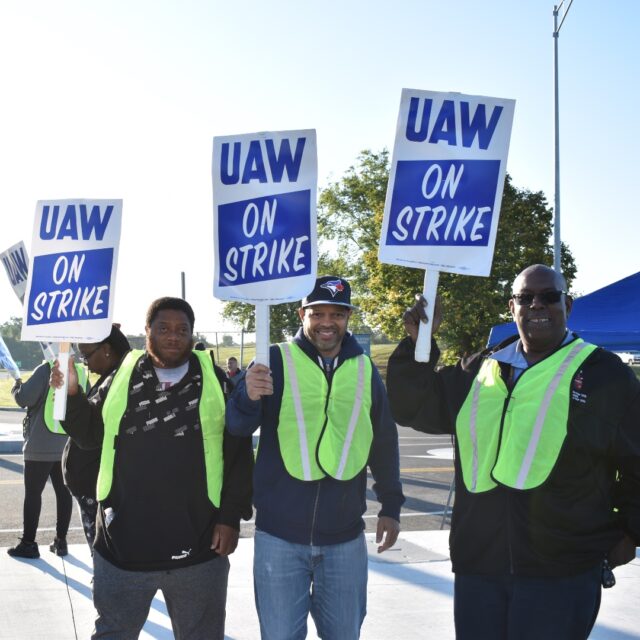
By Julia Dudley Najieb
Black Headline News
DETROIT, Mich.–Thursday morning at 12:00 AM, auto workers from Detroit’s Big Three automakers Ford, General Motors (GM) and Stellantis went on strike under the unified efforts of their union, United Auto Workers (UAW), The Stand Up Strike. (Stellantis N.V. is a multinational automotive manufacturing corporation formed from the merger of the Italian–American conglomerate Fiat Chrysler Automobiles and the French PSA Group. They carry the Jeep, Ram, Chrysler, Dodge and Fiat brands.)
The International Union, United Automobile, Aerospace and Agricultural Implement Workers of America, better known as the UAW, is a union with 400,000 active members and more than 580,000 retired members in the United States, Canada and Puerto Rico. With 600 local unions, the UAW represents workers across the industry, including multinational corporations, small manufacturers, state and local governments, colleges and universities, hospitals and private non-profit organizations, according to their website.
The UAW has over 146,000 members across Detroit’s Big Three: GM employs around 46,000 UAW members, Ford accounts for 57,000 members, and Stellantis has roughly 43,000 UAW members. (Based on 2022 year-end hourly employment data, Ford employs almost 86,000 total workers in the U.S. alone, GM, 124,000 employees in North America according to CNN while Stellantis hires about 56,000 workers in the U.S.)

UAW Facebook: UAW President Shawn Fain speaks September 14 before the looming deadline he is adamant about with the Big Three.
UAW President Shawn Fain remained adamant about the Sept. 14, 11:59 p.m. deadline for the nearly 150,000 members to have a deal in place with the Big Three; a few hours before the strike, he made a statement on Facebook live to the public about the absolute deadline if the demands were not met.
“We’ve been working hard trying to reach a deal for economic and social justice for our members,” said Fain. “We have been firm. We are committed to winning an agreement with the Big Three that reflects the incredible sacrifice and contributions UAW members have made to these companies. We’ve been open. The companies, the members, and the public know what we’ve been fighting for.”
Finally, at midnight Thursday, he called for members to put down their tools and walk off the job since a proposals presented were not adequate according to UAW’s standards. UAW contracts for union autoworkers at the Big Three have officially expired as of September 14. UAW members at three assembly plants in Michigan, Ohio, and Missouri went on strike Thursday. They have targeted specific locations, including the Ford Michigan Assembly Plant (Final Assembly and Paint only) in Wayne, Stellantis’ Toledo Assembly Complex in Ohio and General Motors’ Wentzville Assembly in Missouri. The union’s strike fund, estimated at $825 million, provides the money for strike pay, which amounts to $500 per week. Strike pay is prorated, meaning each day of lost wages on strike — Monday through Friday — counts for an eligible member to receive “one day’s Strike Assistance at the prorated daily amount,” according to UAW guidelines.
In a public statement he made July 19, Fain stated that he has seen the changes in the industry over and almost 30-year period where workers have made sacrifices for the Big Three.
“I’ve been a UAW member for 29 years,” stated Fain. “I come from a GM family. Like CEO Barra, my roots in this industry run back to the early days when two of my grandparents hired in at GM.
Those jobs were life-changing for my family. Their generation took pride in not only being UAW members, but in working for GM.”
“We all have our own walk with the Big Three and UAW so what we do here is personal to all of us.
I’ve watched GM’s Delco radio plant in my hometown where my grandparents and many aunts and uncles worked and retired from, go from Delco to Delphi, to GMCH. I’ve watched it shrink from 15,000 employees to now around seventy. I’ve watched it change with technology from transistor radios to making semiconductors.
And now I’m watching that plant suffer the same fate as many others at the hand of corporate greed.
Throughout my 29 years, during the best and worst of times, our members have always delivered.”
Also in the statement, Fain made inferences about the sacrifices auto workers have made for the company: During the country’s 2008 economic crisis, the auto industry was at extreme risk; GM and Chrysler (now Stellantis) agreed to bankruptcy and government-supported restructuring, according to the Economic Policy Institute September 12 article, UAW-automakers negotiations pit falling wages against skyrocketing CEO pay. While this deal saved jobs throughout the auto sector, it came with steep costs to workers. Union workers agreed to a wage freeze, entry of lower-wage “tiered” workers, and other concessions affecting retiree pensions and health care benefits, the article continued. In 2009, the companies suspended contractual cost of living adjustments and have not had one since.
Meanwhile, General Motors CEO Mary Barra told CBS Mornings they have presented four different offers to the UAW since they have been at the table with them since July 18, receiving 1,000 demands; Barra said GM couldn’t be successful if the company met all of UAW’s demands. The initial demands, she said, were over $100 billion.
In a Facebook live broadcast on August 1, Fain presented “audacious” demands of members in a new four-year contract being negotiated with a Sept. 14 deadline to the Big Three: (see document below from UAW)
- elimination of wage tiers
- substantial wage increases
- restoration of cost of living allowance increases
- defined benefit pension for all workers
- reestablishment of retiree medical benefits
- the right to strike over plant closures
- limits on the use of temporary workers
- more paid time off
- increased benefits to current retirees
Fain accentuated on the record profits of the Big Three in the August 1 Facebook broadcast:
“Ford, General Motors and Stellantis made a combined $21 billion in profits in just the first six months of this year. That’s on top of the quarter-trillion dollars in North American profits that the Big Three made over the last decade.”
“Record profits mean record contracts,” Fain said.
However, the Big Three presidents said they have been working fervently to meet the “audacious” demands of the UAW, which would surmount to unaffordable, unsustainable labor costs for each auto company.
“On the key economic issues that matter most to our UAW-represented employees, Ford has submitted four proposals to the UAW since Aug. 29,” said Ford CEO Jim Farley. “The last offer Ford submitted was historically generous, with large wage increases, cost of living adjustments, more paid time off, additional retirement contributions and more.”
“If implemented, the proposal would more than double Ford’s current UAW-related labor costs, which are already significantly higher than the labor costs of Tesla, Toyota and other foreign-owned automakers in the United States that utilize non-union-represented labor.”
“Ford has bargained in good faith in an effort to avoid a strike, which could have wide-ranging consequences for our business and the economy.”
In a public message to the manufacturing team members, GM listed their record offer on September 14:

GM also commented in the public statement about the 2019 strike that lead to an unsuccessful outcome for everyone.
Stellantis commented that the UAW leadership misrepresented their offer they presented on September 14.
“We have delivered four comprehensive economic proposals to date,” stated Stellantis in a September 16 press release. “Our bargaining team continues to work days, nights and weekends in a responsible manner to fully understand and address each of the Union’s nearly 1,000 demands. Our team continues to take a serious and responsible approach to find creative solutions for each of these demands. We have listened and will continue to bargain in good faith until an agreement is reached.”
“Unfortunately, the UAW’s leadership has decided to call a strike and publicly misrepresent several key elements of our offer. We believe it is imperative to set the record straight and provide the facts of Stellantis’ highly competitive offer, presented on September 14.”
- 21% Wage Increase: The offer currently on the table would provide Stellantis Hourly Employees with cumulative raises of nearly 21% during this next contract, with an immediate 10% increase at the time of ratification. When it comes to profitability, our represented employees have shared in our success, and would continue to do so. During the term of the last agreement, full-time employees saw a total eligible profit-sharing amount of $44,700.
- Additionally, we proposed increasing wages for all our Supplemental Employees with a new starting wage rate of $20 per hour – a $4.22 per hour, or 26.7%, increase.
- 4-Year Progression, Down from 8 Years: We have proposed ending the wage tier in our Mopar parts division and cutting the hourly wage progression timeline in half. This would bring all current full-time hourly workers to the top rate during this next agreement.
- Inflation Protection: In addition to other forms of compensation, such as bonuses, profit sharing and our world class health care plans that carry no monthly premium, we have also proposed an inflation protection measure designed to offset the reduced purchasing power employees have faced over the last few years.
- More than $1 Billion in Retirement Security Improvements: Retirement security commitments include over a billion dollars in funding and improvements to the pension and retirement savings plans for both current employees and retirees.
The elephant in the room: “EVs”
President Joe Biden said this about the contract negotiations between the United Auto Workers and the Big 3 auto companies.
“You know, I’ve been in touch with both parties over — since this began over the last few weeks,” said President Biden. “And over the last — the past decade, auto companies have seen record profits, including the last few years, because of the extraordinary skill and sacrifices of the UAW workers. But those record profits have not been shared fairly, in my view, with those workers. “
Ironically, President Biden is pushing for the auto industry to go electric by 2030, which means fewer employees are needed to assemble these electric vehicles (EV), but higher battery costs. On August 5, 2021, President Biden signed signed an Executive Order to make half of all new vehicles sold in 2030 zero-emissions vehicles, including battery electric, plug-in hybrid electric, or fuel cell electric vehicles. The Executive Order also included the development of long-term fuel efficiency and emissions standards to save consumers money, cut pollution, boost public health, advance environmental justice, and tackle the climate crisis. Also, California in August moved to require all new vehicles sold in the state by 2035 be electric or plug-in electric hybrids. The Environmental Protection Agency (EPA) is also proposing new, stricter emission standards for medium-duty and heavy-duty trucks through 2032. The ambitious goals presented by the Biden Administration, the state of California, and the EPA not to far behind with more regulations, will require more costs for the auto industry to transition from combustible engines to electric. According to NPR’s September 13 news article, Why the transition to electric cars looms large in UAW talks with Big 3 automakers, automakers — spurred in part by generous government tax credits — are pouring billions of dollars into developing and producing EVs. And although EVs are not explicitly at the heart of the union negotiations, they are affecting them in all kinds of ways.
The UAW is concerned about this transition, according to the news article. Several years ago, it summed up the challenge in a white paper: “EV powertrains are mechanically simpler than ICE powertrains,” the union wrote, referring to internal combustion engines. “This simplicity could reduce the amount of labor, and thus jobs, associated with vehicle production.” This challenging opposition for the union is an opportunity for the auto industry to cut cost.
Although the auto industry is concerned about the cost of investing into this EV transition, on Labor Day, the Biden administration announced more than $15 billion in funding to convert auto plants to make EVs and emphasized that high-paying and unionized companies would have a leg up in applying for that money.
The EV-transition debate seems to have fueled both sides of this argument.
In a statement this past Friday regarding the auto strike, The U.S. Chamber of Commerce President and CEO, Suzanne P. Clark, one of the largest business lobby groups, blamed Biden on Friday for inciting the strikes, and said they would result in higher costs for workers not in a union and lost profits for other businesses.
“The UAW strike and indeed the ‘summer of strikes’ is the natural result of the Biden administration’s ‘whole of government’ approach to promoting unionization at all costs. For the 94% of American private sector workers not in a union, the costs are starting to stack up – from increasing consumer costs – now for new cars – to sudden loss in business for those in related industries like auto suppliers, restaurants and caterers whose customers are now on strike. “
Pensions gone from private sectors since early 2000s
The Flint Journal reported in 2006 that effective Jan.1, 2007, GM would freeze the accrued pension benefits for about 42,000 U.S. salaried employees and put them into new plans, a tactic many large companies were using to trim soaring pension costs.
The UAW is asking the Big 3 to restore the traditional defined-benefit pensions for new hires who now receive only 401(k)-style retirement plans; a pension plan is funded by the employer, while a 401(k) is funded by the employee. Pension plans guarantee a monthly check in retirement; a 401(k) does not offer guarantees, explained retirement planning website, protective.com. A multi-employer plan is a pension plan created through an agreement between two or more employers and a union.



You must be logged in to post a comment Login